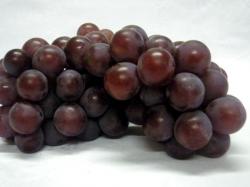Red Niagara Grapes To Be Featured At Fruitlogistica
January 26, 2010 | 2 min to read

Brazil, the worlds third largest producer of fresh fruit, has reserved a splendid surprise for Fruit Logistica 2010, the international food and beverage trade fair that takes place between 3rd and 5th February in Berlin, Germany: the Red Niagara grape will be presented for the first time ever to buyers from around the world. Still relatively unknown in the international market, this variation of the White Niagara has revolutionised the Brazilian table grape market over the last 10 years.
Benassi Sales Director Luci Benassi states, As its flesh is soft, sweet and very juicy, the Niagara has been exceptionally successful, taking over the national market over the course of a mere decade. According to her, the grapes highly distinctive and unique taste is one of the main reasons behind its success; adding: And Benassi is confident that this national phenomenon will be repeated worldwide.
This air of optimism is shared by each of the more than 30 Brazilian companies coordinated by IBRAF [the Brazilian Fruit Institute] and supported by Apex-Brasil [the Brazilian Trade and Investment Promotion Agency] arriving at the trade fair to showcase their varied products. The companies, including producers, exporters, associations and government bodies, will occupy 300 m2 at this edition of Fruit Logistica, the eighth in which Brazil has participated.
IBRAF Executive Manager Valeska de Oliveira states: The Brazilian Fruit stand will feature companies ranging from those with plenty of experience of the international market to those seeking to export for the first time. What they all have in common is their intent to establish permanent and sustainable positions in the international market, instead of focusing on one-off contracts, adding, Brazil is focused on increasing its share of the international market and we hope that 2010 will see an even more positive scenario for Brazilian fruit exports.
GRAPES
Brazil currently produces and exports practically all of the most sought after and valued grape varieties. High technology, a desirable climate, food safety and respect for the environment all add up to Brazilian grapes that have a unique flavour and position in the international market. Grapes produced in Brazil are sweet and mild due to being harvested at their precise moment of ripeness such that each variety contains the perfect balance between acids and sugars.
The production of table grapes destined for export is concentrated in Brazil’s Northeast, in the Vale do So Francisco region, where the semi-arid climate and tropical latitude allows for year-round production. The region is responsible for 96% of Brazilian grape exports, comprising a broad offer of seeded and seedless varieties, and the harvests are targeted at the international off-seasons: April-May and October-November. The Southeast of the country also produces grapes, albeit these are mainly intended for the domestic market, whilst the South is mainly concerned with supplying the wine and juice industries.
Although the Niagara grape is produced throughout the year in various areas spread throughout So Paulo State, harvests peak between December and February.
Source: Apex Brasil
